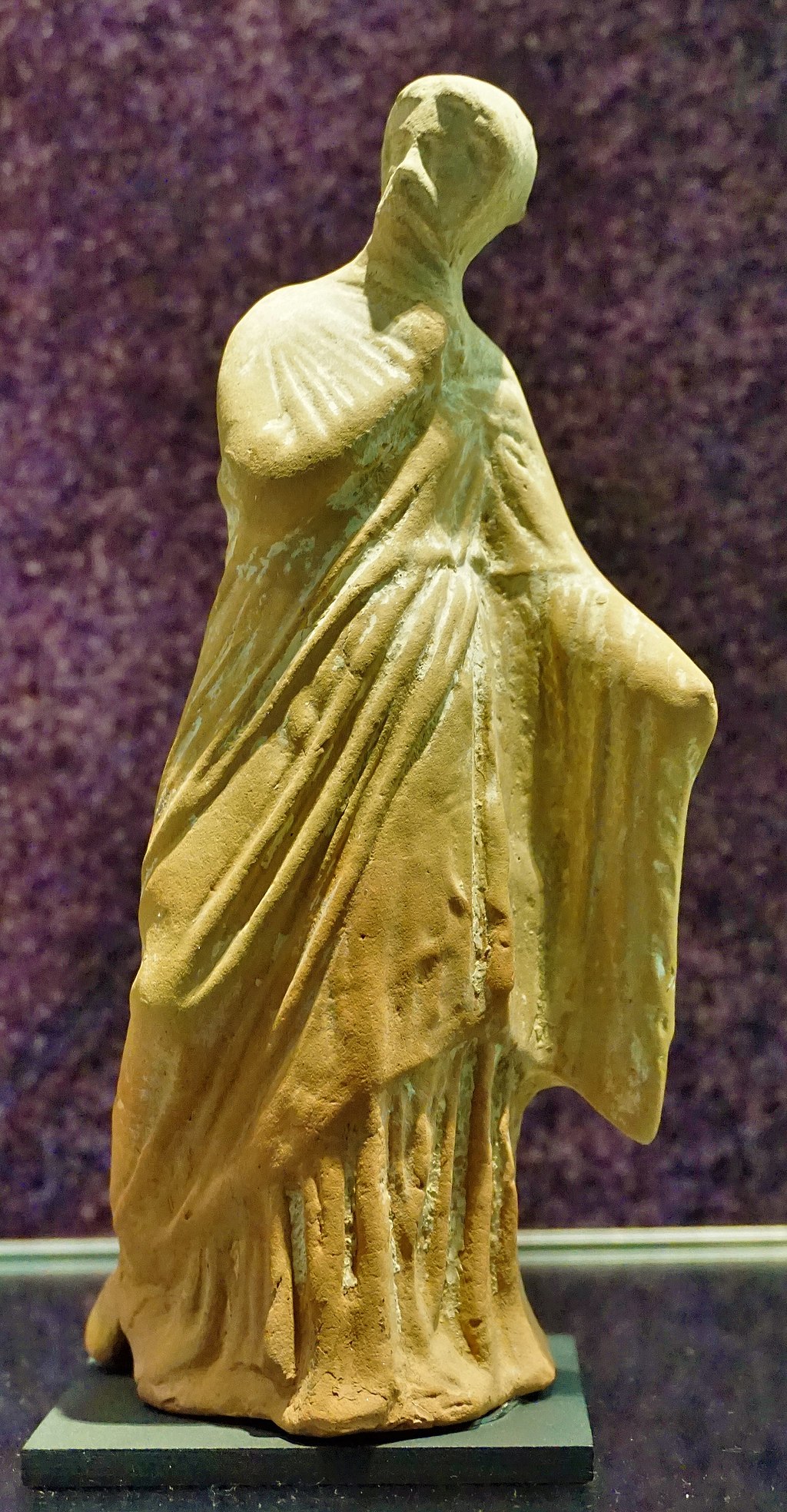
This 2,000-year-old “Figurine of a Dancer” was probably created as a gift for the ancient Roman festival of Saturn in December, a period of general merrymaking and the predecessor of Christmas. The figurine holds traces of pink paint, suggesting that her garments were once bright and colorful, making her an attractive gift for a wealthy family. In ancient Roman culture, sigillaria were pottery or wax figurines given as traditional gifts during the Saturnalia. The Sigillaria on 19 December was a day of gift-giving. Gifts were often the pottery or wax figurines called sigillaria made especially for the Saturnalia festival.
Saturnalia was an ancient Roman festival in honor of the god Saturn, held on 17 December of the Julian calendar and later expanded with festivities through to 23 December. The holiday was celebrated with a sacrifice at the Temple of Saturn, in the Roman Forum, and a public banquet, followed by private gift-giving, partying, and a carnival atmosphere.
During private festivities such as the Saturnalia festivals in the Greco-Roman world, the participation of freeborn Roman women is implied by sources that name gifts for women. Also, female entertainers were undoubtedly present at some of these private festivity gatherings. This Figurine of a Dancer might have originated from such festivals and intended as a festive present.
Gift-giving
The Sigillaria on 19 December was a day of gift-giving. Because gifts of value could mark social status contrary to the spirit of the season, gifts were often focused on pottery or wax figurines called sigillaria made especially for the day. Children sometimes received toys as gifts. In poems about the Saturnalia, a Roman poet names both expensive and relatively cheaper gifts, including writing tablets, dice, money boxes, combs, a hunting knife, an axe, perfumes, pipes, tables, cups, spoons, clothing, statues, masks, books, and pets. Verses also sometimes accompanied the gifts, as do greeting cards today.
Gifts could be expensive but token gifts of low intrinsic value we used for quality friendships. Patrons pass along a gratuity to their poorer clients or dependents to help them buy gifts. Some emperors were noted for their faithful observance of the Sigillaria.
Influence of Sigillaria
Unlike other Roman religious festivals that were particular to cult sites, the prolonged seasonal celebration of Saturnalia at home could be held anywhere in the Empire. Thus, Saturnalia continued as a secular celebration long after it was removed from the official pagan calendar. Saturnalia has left its influence in many medieval and modern customs, occurring about the time of the European winter solstice.
The actual date of Jesus’s birth is unknown, but, in the 4th century AD, Pope Julius I (337–352) formalized that it should be celebrated on 25 December, around the same time as the Saturnalia celebrations. Some have speculated that part of the reason he chose this date may have been because he was trying to create a Christian alternative to Saturnalia.
As a result of the proximity of dates, many Christians in western Europe continued to celebrate traditional Saturnalia customs in association with Christmas and the surrounding holidays. Like Saturnalia of old, Christmas during the Middle Ages was a time of ruckus, drinking, gambling, and overeating.
The custom of gift-giving at Christmas time resembles the Roman tradition of giving sigillaria, and the lighting of Advent candles resembles the Roman culture of lighting torches and wax tapers. Likewise, Saturnalia and Christmas both share associations with eating, drinking, singing, and dancing.
Facts about Christmas
- The word Christmas originates from the words Christ’s Mass. In old English, first recorded in 1038, it means ‘Christian Mass.’
- Kissing under the Mistletoe originated with fertility rites.
- Christmas as a holiday is a recent innovation. Before 1850, December 25 was not a legal holiday in New England. Everyone worked on the 25th, and children went to school.
- The letter X in Xmas is a Greek abbreviation for Christ.
- The origins of Santa Claus trace back to St. Nikolas of Myra, also known as Bishop Saint Nicholas of Smyrna. He lived in modern-day Turkey around 280 AD.
- From 1659 to 1681, Puritan leaders in Boston made it illegal to celebrate Christmas. If you were caught participating in the festivities, you were fined 5 shillings.
- “Jingle Bells” was first written as a Thanksgiving song and was first performed in 1857.
- In the United States, over 30 million trees are sold each Christmas.
- After the American occupation of Japan following World War II, the Japanese embraced Christmas, without the religious obligations, as an occasion for gift-giving.
- Christmas is one of the most profitable times of the year for many businesses.
- Santa Claus used to wear blue and white and green in the past; his traditional red suit came from a 1930s ad by Coca Cola.
- “White Christmas” is the best-selling song of all time.
Reflections
- Is gift-giving as old as humanity?
- Name: Figurine of a Dancer
- Provenance: Morgantina, Italy
- Date: 250-225 BC
- Material: Terracotta
- Museum: RD Milns Antiquities Museum
A Tour of the RD Milns Antiquities Museum
- Lekythos with Woman
- Gravestone for Theophile
- Figurine of a Dancer
- Fish Plate
A Tour of Brisbane’s Museums
- Queensland Art Gallery
- Queensland Museum & Science Centre
- MacArthur Museum Brisbane
- RD Milns Antiquities Museum
- Queensland Maritime Museum
- Commissariat Store, Brisbane
- Queensland Police Museum
~~~
“I declare
That later on,
Even in an age unlike our own,
Someone will remember who we are.”
– Sappho
~~~
Photo Credit: GM
Popular this Week








 Sponsor your Favorite Page
Sponsor your Favorite Page SEARCH Search for: Search Follow UsJoin – The JOM Membership Program
Sponsor a Masterpiece with YOUR NAME CHOICE for $5
Share this:
- Tweet
